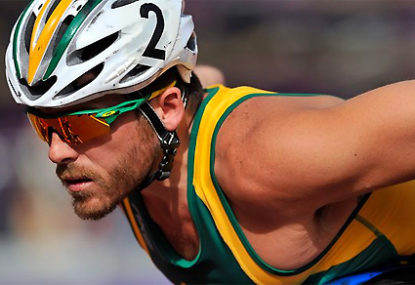'An iconic roster': LeBron, Steph, KD headline all-star cast for Team USA's shot at Olympic glory
LeBron James is going back to the Olympics for the first time in 12 years. Steph Curry is headed to the games for the…

It’s an age-old paradox – what happens when an irresistible force meets an immovable object?
The two can’t exist together, and in the case of Australia’s Paralympic heroes the immovable object is always proven movable in the end.
This is made all the more impressive given supposedly unstoppable humans, operating with all of their faculties intact, can be derailed by such small trifles as hangovers, bad hair days and unreliable public transport.
So while we mere humans let the little things come out on top of the paradox, those who battle seemingly impossible adversity to triumph as Paralympians are like superheroes with a myriad of powers at their disposal: courage, determination and unshakeable self-belief.
And the very best of them have battled the twin kryptonite of the hand dealt them by nature and the occasional ambivalence of the Australian sporting public to be embraced.
Not just as Paralympians, but as sporting icons to rival our most revered.
Louise Sauvage was to the Sydney 2000 Paralympics what Cathy Freeman was to the Olympics concluded three weeks prior – the bearer of the torch to light the cauldron, and the home town golden girl on the grandest stage when the action got started.
The highlight? Gold in front of 110,000 spectators in the 800m women’s wheelchair demonstration race held during Freeman’s fortnight-long victory lap of Stadium Australia.
Sauvage had over 20 operations before the age of ten due to a severe spinal injury, switching from the pool to the track at 14 after operations to correct curvature of the spine. “You never know what you can achieve until you try” is the motto that drove her to nine gold medals and two silver medals across three Paralympic Games, two Olympic gold medals and four wins in the Boston marathon.
Even as far as unstoppable forces go, wheelchair racer Kurt Fearnley is an overachiever: a four-time Paralympian with three gold medals and several handfuls of silver and bronze to his name. The long-distance specialist has also racked up multiple first placings in the New York, London and Chicago marathons.
Seemingly not content with smashing the competition in his discipline of choice, in his spare time Fearnley has completed the Sydney to Hobart yacht race on 2011 line honours winner Loyal, climbed the 1504 fire stairs of the iconic Sydney tower, and crawled the Kokoda track. That’s 96 kilometres, or two marathons and change, on his hands.
Fearnley credits his parents’ encouragement of him as a child with his indomitable spirit and adventurous attitude. “There is so much out there that you can climb,” Fearnley told ABC Radio breakfast host Robbie Buck in November 2014, “and if there’s a mountain, why not climb it? Why not see what’s on the other side?” All from a guy missing parts of his spine and all of his saprum (the apex of the spine and legs); a guy who at birth doctors thought would be lucky to survive a week.
And they’re just the towering figures of the Paralympic movement. Then there’s wheelchair rugby rep George Hucks, who showed he actually was stoppable when he shattered a kneecap in a pre-1996 Paralympics scrimmage, but recovered to take silver with the Steelers in 2000 and 2008.
Peter Leeks, who conquered cerebral palsy to smash four world and four Paralympic record on his way to eight medals in Beijing. Cosmopolitan’s inaugural “fun fearless female” Marayke Jonkers, paraplegic from a car crash as an eight-month-old but now a motivational speaker and two-time Paralympian in the pool.
And hall-of-famer Frank Ponta, who in 1954 was one of the first people admitted to Australia’s first spinal care unit, but took his love of sport through five Paralympic campaigns in athletics, basketball, fencing, swimming and precision javelin.
When I got to the end of my first half-marathon, nothing about the experience made me want to push through and complete the course in full next time round.
But maybe Kurt Fearnley is right. Maybe it’s worth pushing past the immovable object at the top of the mountain to see what’s on the other side.